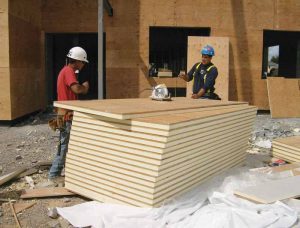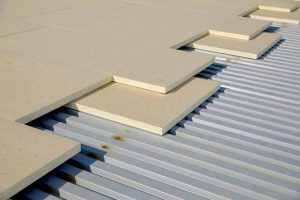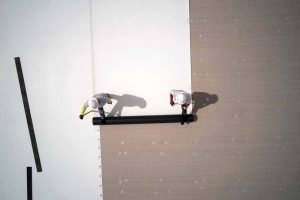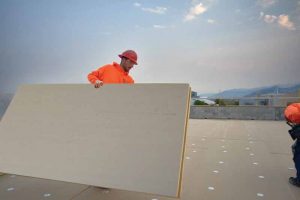Polyiso: Maximizing sustainability in high-performance buildings
by arslan_ahmed | November 6, 2023 11:00 am
 [1]
[1]By Justin Koscher
The construction industry is one of the country’s largest energy consumers and contributors of greenhouse emissions. However, to mitigate its impact on the environment, it has set long-term sustainability targets and is heading toward decarbonization.
Efforts to decarbonize begin with reducing U.S. energy consumption, for which minimum performance standards and building energy codes are increasing in both scope and stringency. As a result, the use of energy-efficient materials and building practices is accelerating. This has led to the growing popularity and demand for high-performance buildings.
As building operations alone account for 30 percent of global final energy consumption, examining building envelope thermal performance is key to achieving energy efficiency and elevating overall building performance. Among the many energy drains, heating and air conditioning are two of the most resource-intensive activities that will test the performance of a building’s envelope (roof, walls, and windows). To prioritize thermal performance, specifiers are putting high-performance building materials to work, including polyisocyanurate (polyiso) insulation.
Examining the high-performance insulation solution
Polyiso is a closed-cell, rigid foam board insulation consisting of a thermoset foam core sandwiched between two durable facers. The material provides excellent resistance to heat gain and loss, offering one of the highest R-values per inch compared to other insulation options. Polyiso can be used in wall assemblies, roofing systems, and below-grade applications to create a well-insulated building envelope. Easy to handle, lightweight, and versatile, polyiso panels can be manufactured in a variety of thicknesses and dimensions to meet specific project needs. Since polyiso is a proven solution to address energy performance, it can be a key part of a specifier’s strategy to promote energy efficiency and sustainability in the built environment.
Types of polyiso
There are many different types of polyiso insulation boards based on the classification system in ASTM C1289, Standard Specification for Faced Rigid Cellular Polyisocyanurate Thermal Insulation Board. They are categorized based on the facers which range from foil facers, glass reinforced facers, coated glass facers, all glass facers, perlite board, cellulosic fiberboard, oriented strand board, plywood, and glass mat-faced gypsum board. Not only do facers contain the foam core during the production process, but they also add strength and dimensional stability to the finished polyiso board. Each facer has its own distinct properties, including reduced water absorption and water vapor permanence, restricted air movement, and increased thermal resistance. Further, some provide a drainage plane to shed water and others can add structural properties to wall and roof assemblies. Building teams can specify polyiso by facer type and other physical properties to align with their specific needs, which can help them achieve compliance with increasingly stringent building performance standards.
 [2]
[2]Polyiso continuous insulation (ci) mitigates thermal bridging
Traditional construction practices place insulation between framing members (wood or steel studs), which leaves thermal bridges for heat transfer between indoor and outdoor spaces. Continuous insulation (ci) is an uninterrupted layer over the entire opaque surface of a building’s interior or exterior, which reduces energy transfer due to thermal bridging.
For exterior walls, building teams can specify polyiso ci with a wide variety of structural wall systems and cladding materials such as brick veneer, metal composite material (MCM) panels, and vinyl siding. Sheathing materials such as oriented strand board (OSB) or plywood can also be used. About 12.7 mm (0.5 in.) thick polyiso ci with a R-value of 3.2 can deliver approximately six times the insulation value of OSB or plywood alone, which has an approximate R-value of 0.5 per 12.7 mm (0.5 in.) or 11.11 mm (0.4375 in.) thick sheet. This continuous layer reduces thermal bridging while the increased R-value improves the efficiency of the structure.
Polyiso ci is lightweight compared to other insulation options like mineral wool. Using lighter-weight insulation materials can reduce the need for more robust (i.e. larger size and longer) attachment systems that are required to support heavier insulation options. Typically, additional fasteners or bulky attachment systems will increase the impact of thermal bridging and decrease the efficiency of the insulation. Therefore, by specifying lighter-weight insulation such as polyiso, specifiers can realize the compounding benefits of reduced thermal bridging. In addition, polyiso has a higher R-value per inch compared to mineral wool and, thus, requires a thinner insulation profile in-wall assembly to meet energy-code compliance. This may reduce the size of the attachment system for the cladding and reduce thermal bridging.
Polyiso ci offers superior value and performance as a three-in-one building envelope solution to reduce energy loss, mitigate air leakage, and minimize the risk of moisture intrusion. With properly sealed joints, polyiso ci is available as an approved and code complaint water-resistive barrier (WRB) and can act as an efficient air barrier. In fact, it can remove the need for wall cavity insulation when installed at appropriate thicknesses to meet energy code requirements. By specifying polyiso ci in building systems, specifiers can minimize additional material needs and their associated carbon emissions from manufacturing, transportation, and installation, without compromising building performance.
 [3]
[3]Supporting energy-efficient building upgrades and retrofits
According to the latest Buildings Energy Consumption Survey conducted by the U.S. Energy Information Administration (EIA),1 commercial buildings, on average, are 42-years-old. When they were first built, their project teams would not have prioritized energy efficiency, nor did they have access to the advanced building materials and technologies available today. In turn, the U.S.’s aging building infrastructure might not be equipped to deal with the fluctuating temperatures across seasons due to the impacts of climate change. This results in the building envelope and thermal appliances having to work harder to reduce heat transfer and maintain stable interior temperatures.
Due to its versatility and thermal performance, polyiso is a proven solution to support energy-efficient retrofits on commercial buildings. Prioritizing such upgrades can elevate the performance of existing buildings, which can help make them more energy-efficient and prolong their service life. According to a report conducted by ICF,2 an international consulting firm with expertise in the energy and efficiency sector, insulation upgrades can reduce about 10 billion tons (9 billion tonnes) of carbon emissions over a period of 50 years. In addition, such practices can replace the need for newer buildings with stable thermal performance, eliminating the carbon-intensive process of new construction. As stated perfectly by Carl Elefante, former president of the American Institute of Architects (AIA), “The greenest building is one that is already built.”
Looking beyond thermal performance
Polyiso works from a performance standpoint and contributes to reducing a structure’s carbon footprint by improving its energy performance. However, there is more to polyiso than its insulating properties. Polyiso’s well-tested fire performance and effective resistance to moisture and water intrusion can help to safeguard a building from the associated damage, repair, and replacement. Reduced maintenance and replacement needs can reduce the carbon emissions associated with new materials used for frequent replacement projects.
Meeting fire safety code requirements
Construction materials, including foam plastic insulation such as polyiso, require a suitable margin of fire safety. Thanks to its unique structure of strong isocyanurate chemical bonds, polyiso is tested to deliver code-required fire performance for a wide range of applications. For example, polyiso products are available as a Class A product, with a flame spread of 25 or less as tested in accordance with ASTM E84. In addition, polyiso can resist temperatures up to 198 C (390 F), which is more than twice the temperature resistance of some other building insulation products. In turn, polyiso products deliver exceptional versatility and can be used to meet the demands of modern building envelope assembly configurations.
Fire performance in roofs and wall assemblies
Building codes are especially stringent for exterior walls of commercial buildings and in many cases, the products must meet a flame spread index of 25 or less and a smoke-developed rating of 450 per ASTM E84. Polyiso stays intact by neither melting nor dripping during fire exposure. Instead, the product forms a protective surface char that enhances its fire resistance by reducing flame spread. In fact, many exterior wall assemblies with polyiso pass the stringent NFPA 285 test and those assemblies can be used in buildings of any type and any height.
 [4]
[4]Polyiso is also the only foam plastic insulation product approved for direct application to steel decks to earn FM approval for Class 1 roof systems. This means the roof assembly with polyiso has successfully passed a series of tests which include external and internal fire exposure, wind uplift, water leakage, and impact resistance. As a result, polyiso direct-to-deck assemblies meet NFPA 276 (FM 4450) or UL 1256 standards and can be installed without a thermal barrier.
Reducing the environmental footprint
While one arm of sustainability is the efficient functioning of the material, the other is its impact on the environment. To fully understand a material’s footprint, it is important to account for greenhouse gases (GHGs) emitted during the entire life cycle of the material, from the extraction of raw materials to the disposal of the product.
Polyiso manufacturers recognize the significance of these comprehensive factors and attempt to minimize their environmental impact through product design and production processes to promote sustainability. Polyiso manufacturers put their commitment to sustainability into action in several compelling ways.
Transparency through EPDs
The Polyisocyanurate Insulation Manufacturers Association (PIMA) publishes third-party verified, ISO-compliant Environmental Product Declarations (EPDs) that provide industry-averaged environmental impact information for polyiso products manufactured across the U.S. and Canada. These cradle-to-grave reports cover the full product life cycle of polyiso insulation over a 75-year building service life, as specified in the Product Category Rule for thermal insulation. It includes environmental impacts from the supply, and transport of raw materials as well as the manufacturer, transport, installation, replacement (in the case of roofing materials), and disposal of polyiso products.
For roof applications, the EPDs are applicable to polyiso roof insulation manufactured with glass fiber-reinforced felt facers and polymer-bonded coated glass facers (ASTM C1289, Type II, Class 1 and 2). Similarly, the EPDs for wall applications are applicable to polyiso insulation commonly used in commercial and residential construction with glass fiber reinforced aluminum foil facer (ASTM C1289, Type I, Class 1 and 2). EPDs also available for polyiso HD cover boards manufactured with polymer-bonded coated glass facers (ASTM C1289, Type II, Class 4; CAN/ULC S704.1, Type 4, 5, and 6). These reports provide one piece of the sustainability puzzle, making it possible for project teams to make environmentally conscious decisions during the specification process.
Blowing agents that safeguard the environment
Blowing agents are often used in insulating materials to increase the final thermal resistance and facilitate the manufacturing of the foaming process. However, these agents come with a global warming potential (GWP). Manufacturers of polyiso insulation products in North America produced one of the first rigid foam insulations to be formulated using a blowing agent without chlorofluorocarbons (CFCs), hydrochlorofluorocarbons (HCFCs), or hydrofluorocarbons (HFCs). Instead, polyiso manufacturers use pentane or pentane blends in their production processes, which is a hydrocarbon with zero ozone-depletion potential (ODP) and a GWP value of less than 10 to ensure code compliance and reduce its environmental impact. In addition, polyiso products are available with other environmental certifications such as Underwriters Laboratories (UL) Greenguard Gold certification, which verifies those products meet or exceed UL’s standards for volatile organic compound (VOC) emissions.
 [5]
[5]Prolonged service life and reusable properties
According to research published by Architecture 2030, the embodied carbon of a material is highest during its manufacturing process in most cases.3 The same studies have shown that in the first 30 years, embodied carbon can account for more than half of the emissions for a typical building and up to 80 percent of the emissions for a high-performance building. However, unlike most other construction materials, energy-saving products such as polyiso insulation offer the opportunity to recoup the product’s associated embodied carbon emissions by significantly reducing the environmental impacts of building operations. This is an important distinction for consideration in the early stages of a project’s design cycle when specifiers are considering how to prioritize carbon “budgets” for material selection.
Not only does polyiso reduce the carbon footprint by delivering improved thermal performance, but polyiso products can also be manufactured with raw materials that utilize recycled content (most commonly as part of the product’s facing materials). Building professionals may also seek opportunities to reduce environmental impacts through appropriate product reuse. While each building and project is unique, it may be possible to reuse polyiso roof insulation during a building’s roof replacement project. To help specifiers better understand the typical life cycle of a polyiso roofing products, the EPDs for polyiso roof insulation and HD cover boards assume the polyiso products will be replaced once during a building’s 75-year service life. This is typical industry practice and an important reminder for building practitioners to review the details
of other product EPDs that may not factor in a replacement cycle for the covered products.
Prioritizing energy-efficient building
Specifiers, architects, and construction professionals can consider using polyiso to meet stringent code requirements while enhancing a building’s energy efficiency and meeting sustainability goals.
Polyiso insulation is a material that supports new construction and retrofit upgrades and can be implemented across the building envelope to accommodate individual project needs. Aside from its high-performance properties, polyiso manufacturers are conscious of the material’s environmental impact and have a demonstrated history of reducing environmental impacts over time. By specifying polyiso, today’s industry professionals can deliver proven performance to any project—no matter its scope or the size of its sustainability aspirations.
Notes
1 See the building characteristics report, Commercial Buildings Energy Consumption Survey (CBECS), U.S. Energy Information Administration (EIA)
www.eia.gov/consumption/commercial/data/2018/pdf/CBECS_2018_Building_Characteristics_Flipbook.pdf[6].
2 For more details, see www.polyiso.org/page/EnergyCarbonSavingsAnalysis.[7]
3 Refer to https://architecture2030.org/embodied-carbon-actions/[8] for more details.
 Author
Author
Justin Koscher is the president of the Polyisocyanurate Insulation Manufacturers Association (PIMA). In this role, he is the principle staff member for the board of directors and steering committee. His responsibilities include the implementation of the association’s strategic vision, management of finances and administration, and supervision of various PIMA work groups. Koscher joined PIMA in January 2017. He previously served as a director at the American Chemistry Council’s Center for the Polyurethanes Industry. He obtained his B.A. from Illinois Wesleyan University and J.D. from DePaul University College of Law.
- [Image]: https://www.constructionspecifier.com/wp-content/uploads/2023/11/PIMA_CS_Nov23_01.jpg
- [Image]: https://www.constructionspecifier.com/wp-content/uploads/2023/11/GAF_COM_GainesvilleTX_ISO-Board_0881.jpg
- [Image]: https://www.constructionspecifier.com/wp-content/uploads/2023/11/BozemanMT_ISO-Board-and-TPO_4632.jpg
- [Image]: https://www.constructionspecifier.com/wp-content/uploads/2023/11/GAF_COM_GainesvilleTX_ISO-Board_0136_Drone.jpg
- [Image]: https://www.constructionspecifier.com/wp-content/uploads/2023/11/PIMA_CS_Nov23_02.jpg
- www.eia.gov/consumption/commercial/data/2018/pdf/CBECS_2018_Building_Characteristics_Flipbook.pdf: https://www.eia.gov/consumption/commercial/data/2018/pdf/CBECS_2018_Building_Characteristics_Flipbook.pdf
- www.polyiso.org/page/EnergyCarbonSavingsAnalysis.: https://www.polyiso.org/page/EnergyCarbonSavingsAnalysis
- https://architecture2030.org/embodied-carbon-actions/: https://architecture2030.org/embodied-carbon-actions/
Source URL: https://www.constructionspecifier.com/polyiso-maximizing-sustainability-in-high-performance-buildings/